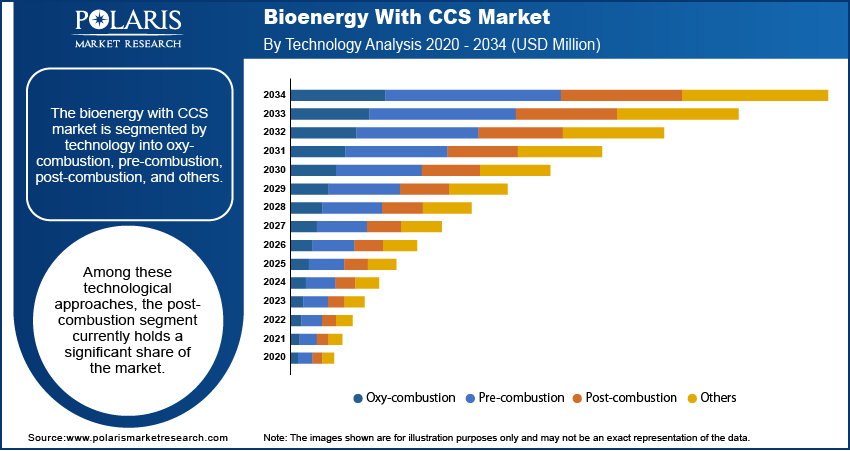
Bioenergy With CCS Market Size, Share, Trends, Industry Analysis Report
: By Technology (Oxy-combustion, Pre-combustion, Post-combustion, and Others), Application, and Region (North America, Europe, Asia Pacific, Latin America, and Middle East & Africa) – Market Forecast, 2025–2034
- Published Date:Sep-2025
- Pages: 120
- Format: PDF
- Report ID: PM5663
- Base Year: 2024
- Historical Data: 2020-2023
Market Overview:
The bioenergy with CCS market size was valued at USD 251.16 million in 2024, exhibiting a CAGR of 19.8% during 2025–2034. Growing climate commitments, CCS technology improvements, and supportive government policies are collectively driving rapid adoption and expansion of the market.
Key Insights
- Post-combustion technology is widely adopted due to its compatibility with existing bioenergy infrastructure and mature capture processes.
- Biomass conversion dominates the application segment as it encompasses the core processes of transforming biomass into usable energy.
- Europe leads the market due to early adoption, strong policy frameworks, and significant funding for BECCS innovation and deployment.
- Asia Pacific is the fastest-growing region, driven by rising energy needs, biomass availability, and strong government support for clean tech.
Industry Dynamics
- Rising global pressure to achieve net-zero targets is accelerating the adoption of BECCS as a viable negative emissions solution.
- Technological advancements in carbon capture and storage are improving system efficiency, lowering costs, and increasing project feasibility across regions.
- Supportive government policies, including tax incentives and carbon pricing mechanisms, are driving investment and large-scale implementation of BECCS projects.
- Growing interest in coupling BECCS with hydrogen production enhances its appeal in the transition to clean, multi-output energy systems.
- High capital costs, infrastructure challenges, and regulatory uncertainties remain significant barriers to widespread deployment, especially in emerging markets.
Market Statistics
2024 Market Size: USD 251.16 million
2034 Projected Market Size: 1,526.53 million
CAGR (2025–2034): 19.8%
Europe: Largest market in 2024

To Understand More About this Research:Request a Free Sample Report
The Bioenergy With Carbon Capture and Storage (BECCS) market represents a dual-pronged approach to energy generation and carbon dioxide removal. At its core, BECCS involves the utilization of biomass – organic matter from plants – as a fuel source to produce energy. This biomass absorbs CO2 from the atmosphere during its growth, making it a renewable resource. The critical second step in BECCS is the capture of the carbon dioxide released during the energy generation process, whether through combustion, fermentation, or other conversion methods. This captured CO2 is then permanently stored, typically in deep geological formations, preventing its release into the atmosphere. The primary appeal of BECCS lies in its potential to achieve negative emissions, as the amount of CO2 stored can exceed the emissions produced throughout the entire lifecycle, including biomass cultivation and transportation.
Several factors are driving the market drive for bioenergy with CCS. Increasing global commitments to climate change mitigation and the pursuit of net-zero emission targets utilizing emission monitoring system (EMS) are significant market growth factors. BECCS is recognized as one of the few technologies capable of actively removing carbon dioxide from the atmosphere while simultaneously generating energy, positioning it as a crucial component in climate action strategies. Furthermore, advancements in Carbon Capture and Storage (CCS) technology, leading to improved efficiency and reduced costs, enhance the economic viability and market potential of BECCS projects. Government support through policies, incentives, and investments in clean energy initiatives further propels the market development and market penetration of BECCS technologies across various applications, including power generation and industrial processes.
Market Dynamics:
Increasing Global Climate Change Mitigation Targets
The escalating urgency to address climate change and limit global warming is a fundamental market drive for the Bioenergy With CCS (BECCS) market. Numerous governments worldwide have set ambitious targets for reducing greenhouse gas emissions, often including commitments to achieve net-zero emissions by mid-century. The EU aims to reduce net greenhouse gas emissions to at least 55% below 1990 levels by 2030 and achieve climate neutrality by 2050, necessitating the exploration of carbon removal solutions (European Environment Agency).
BECCS technology is increasingly recognized as a pivotal solution in achieving these goals due to its unique capability to generate energy while simultaneously removing carbon dioxide from the atmosphere, offering the potential for negative emissions. This positions BECCS as a critical tool in strategies aimed at staying within the temperature limits outlined in international agreements like the Paris Agreement. The demand for technologies like BECCS, which offer both energy production and carbon removal, is expected to surge, significantly driving the market growth of the bioenergy with CCS market.
Advancements in Carbon Capture and Storage (CCS) Technology
Progress and innovation in carbon capture and storage (CCS) technologies are crucial market growth factors for bioenergy with the CCS market. The effectiveness and economic viability of BECCS are intrinsically linked to the efficiency and cost-effectiveness of capturing and permanently storing the carbon dioxide produced from biomass energy conversion. Continuous research and development efforts are leading to more efficient capture methods, lower energy penalties associated with the capture process, and reduced costs for both capture and storage infrastructure. These advancements enhance the overall economic competitiveness and market potential of BECCS projects, making them a more attractive option for both energy producers and governments seeking carbon mitigation solutions. Furthermore, the development of robust and secure geological storage sites and the establishment of transportation networks for captured CO2 are critical enablers for the widespread deployment of BECCS. As CCS technology matures and becomes more readily available and affordable, it significantly bolsters the feasibility and drives the market penetration of the bioenergy with CCS market.
Government Policies and Incentives Supporting BECCS Deployment
Supportive government policies and financial incentives play a pivotal role in shaping the market dynamics and accelerating the market development of the bioenergy with CCS market. Recognizing the significant potential of BECCS in achieving climate goals, governments in various regions are implementing policies that encourage its adoption. Government incentives like the 45Q tax credit in the US provide financial support for BECCS projects based on the amount of CO2 captured and stored (Carbon Gap).
These policies can include direct financial support such as grants, subsidies, and tax credits for BECCS projects, as well as the establishment of carbon pricing mechanisms that create an economic incentive for carbon capture and storage. Furthermore, regulatory frameworks that facilitate the development of CCS infrastructure, such as pipeline networks and storage site permitting, are crucial for enabling the deployment of BECCS at scale. Government commitments to investing in research and development related to BECCS and CCS technologies also contribute significantly to the market potential and long-term sustainability of the sector. Such supportive policy environments reduce investment risks and enhance the economic attractiveness of BECCS, thereby stimulating market demand and fostering market growth.

Segment Insights:
Market Assessment – By Technology
The bioenergy with CCS market is segmented by technology into oxy-combustion, pre-combustion, post-combustion, and others. Among these technological approaches, the post-combustion segment currently holds a significant share of the market. This dominance can be attributed to its relative maturity and applicability to a wider range of existing bioenergy power plants. Post-combustion capture technology involves separating CO2 from the flue gas after the biomass fuel has been combusted. This method offers the advantage of being retrofittable to existing infrastructure, making it a more readily deployable solution for immediate carbon emission reduction from bioenergy facilities. The established understanding of post-combustion processes and the availability of developed technologies contribute to its current widespread adoption and substantial market share within the bioenergy with CCS market. This segment benefits from ongoing research and development aimed at improving efficiency and reducing costs associated with solvent-based capture, which is a commonly used post-combustion technique.
The pre-combustion segment is anticipated to exhibit the highest growth rate within the bioenergy with CCS market in the coming years. Pre-combustion capture involves converting the biomass fuel into a syngas, which is primarily composed of hydrogen and carbon monoxide, before combustion. The CO2 is then separated from the syngas, and the hydrogen-rich fuel is used for power generation. While requiring more significant modifications to existing power plants or the development of new integrated gasification combined cycle (IGCC) plants, pre-combustion offers the potential for higher capture efficiencies and the production of hydrogen as a valuable co-product. As the demand for clean hydrogen as an energy carrier increases and advancements in gasification technologies continue, the pre-combustion segment is poised for rapid expansion and significant market development within the broader bioenergy with CCSlandscape. This growth is driven by the potential for cleaner energy production and the synergistic benefits of hydrogen production alongside carbon capture.
Market Evaluation– By Application
The bioenergy with CCS market is segmented by application into biomass conversion and carbon storage. Currently, the biomass conversion segment accounts for the largest portion of the market share. This prominence is due to the fundamental nature of this sub-segment, which encompasses the various processes involved in transforming biomass into energy, the initial and essential step in the BECCS value chain. The technologies and infrastructure associated with biomass sourcing, handling, pre-treatment, and subsequent conversion into usable energy forms like electricity, heat, or biofuels are more established and have seen greater investment to date. This foundational aspect of energy generation from biomass, coupled with the growing interest in integrating carbon capture technologies, solidifies the biomass conversion segment's current market share in the bioenergy with CCS market.
The carbon storage segment is expected to experience the highest growth rate within the bioenergy with CCS market in the forecast period. This surge in growth is propelled by the increasing recognition of the critical role of permanent geological storage in achieving negative emissions. As more BECCS projects move from pilot phases to commercial deployment, the demand for secure and large-scale carbon dioxide storage solutions will escalate significantly. Advancements in storage site characterization, infrastructure development for CO2 transportation, and regulatory frameworks governing carbon storage are key factors driving this rapid expansion. The long-term success and environmental integrity of BECCS heavily rely on the effective and safe storage of captured carbon, making this segment a focal point for future investment and innovation, thus indicating its high market potential and anticipated growth within the bioenergy with CCS market.

Regional Footprint
Referring to available industry reports, a broad overview of the regional landscape for the bioenergy with CCS market reveals a diverse distribution of activity and potential. Europe and North America have emerged as early adopters and significant players, driven by stringent environmental regulations, supportive government policies, and established technological infrastructure. The Asia Pacific region is witnessing increasing interest and investment, fueled by growing energy demand and a rising focus on sustainable development. Latin America and the Middle East & Africa, while currently holding smaller market shares, present considerable long-term potential due to abundant biomass resources and increasing awareness of carbon mitigation strategies. The market development across these regions is influenced by varying factors such as policy frameworks, availability of biomass feedstock, technological maturity, and investment in CCS infrastructure, shaping the global market dynamics of Bioenergy With CCS.
Europe currently holds the largest share of the bioenergy with CCS market. This dominant position is primarily attributed to the region's proactive climate policies, including ambitious emission reduction targets and strong support for renewable energy technologies coupled with carbon capture. Several European countries have been at the forefront of piloting and implementing BECCS projects, benefiting from established research and development capabilities and significant public and private investment in sustainable energy solutions. Furthermore, the presence of stringent regulatory frameworks and carbon pricing mechanisms provides a strong economic incentive for the deployment of carbon capture, utilization and storage technologies in conjunction with bioenergy, solidifying Europe's leading market share in the global bioenergy with CCS market. This early mover advantage and continued policy support contribute significantly to the region's current market standing.
The Asia Pacific region is anticipated to exhibit the highest growth rate in the bioenergy with CCS market over the coming years. This rapid expansion is driven by the region's increasing energy demand, coupled with a growing emphasis on environmental sustainability and the need to diversify energy sources. Countries in this region are increasingly recognizing the potential of BECCS to contribute to their climate goals while leveraging their significant biomass resources, particularly from agricultural and forestry sectors. Rising government investments in clean energy technologies, coupled with growing awareness of carbon capture and storage, are creating a favorable environment for the deployment of BECCS projects. As technological advancements become more accessible and the economic viability of BECCS improves, the Asia Pacific region is poised for substantial market development and is expected to witness the fastest market penetration in the global bioenergy with CCS market.

Key Players and Competitive Insights
Key participants actively involved in the bioenergy with CCS market include Drax Group plc, [Mitsui & Co., Ltd.], Orsted A/S, Stockholm Exergi AB, [Østfold Energi AS], [Hafslund Eco Vannkraft AS], [Varme Værdien A/S], [CarbonCapture Inc.], [Storegga Geotechnologies Ltd.], and [Aker Carbon Capture ASA]. These entities are engaged in various aspects of the BECCS value chain, from biomass sourcing and energy generation to carbon capture technology development and deployment, as well as carbon storage solutions. Their ongoing activities and developments underscore the dynamic nature of this evolving market.
The competitive landscape of the bioenergy with CCS market is characterized by a mix of established energy companies, specialized technology providers, and infrastructure developers. Competition exists in areas such as the efficiency and cost-effectiveness of carbon capture technologies integrated with bioenergy processes, the scalability and reliability of biomass supply chains, and the availability and accessibility of suitable geological storage sites. Strategic collaborations, partnerships, and investments in research and development are crucial for companies seeking to gain a competitive edge. The market entry assessments for new players often focus on technological innovation or the ability to establish robust and sustainable value chains. Overall, the market insights suggest a growing intensity of competition as the market potential of BECCS becomes more apparent and the market demand for negative emission technologies increases.
Drax Group plc, headquartered in Selby, United Kingdom, operates a large-scale biomass power station that is actively pursuing BECCS. Their offerings include electricity generation from sustainable biomass sources and the development of carbon capture technology for their power plant emissions, with plans for permanent geological storage. Their focus on integrating carbon capture into their existing bioenergy operations makes them a significant player in demonstrating the feasibility and scalability of BECCS for power generation.
Aker Carbon Capture ASA, with its main office in Lysaker, Norway, specializes in providing carbon capture technologies, including solutions applicable to bioenergy power plants and industrial facilities utilizing biomass. Their offerings encompass various capture technologies, such as amine-based post-combustion capture, which can be integrated with different bioenergy conversion processes. Their expertise lies in the design, engineering, and delivery of carbon capture plants, positioning them as a key technology provider for the growth of the bioenergy with CCS market.
List of Key Companies:
- Aker Carbon Capture ASA
- CarbonCapture Inc.
- Drax Group plc
- Hafslund Eco Vannkraft AS
- Mitsui & Co., Ltd.
- Orsted A/S
- Storegga Geotechnologies Ltd.
- Stockholm Exergi AB
- Varme Værdien A/S
- Østfold Energi AS
Bioenergy With CCS Industry Developments
- April 2025: The European Investment Bank (EIB) has sanctioned a €260 million (approximately US$285.39 million) loan to Stockholm Exergi to support the development of Sweden’s first large-scale bioenergy facility equipped with carbon capture and storage (CCS) technology.
- June 2024: Frontier has purchased $48.6 million worth of bioenergy with carbon capture and storage (BECCS) credits from Stockholm Exergi, reinforcing its commitment to advancing carbon removal initiatives.
Bioenergy With CCS Market Segmentation
By Technology Outlook (Revenue-USD Million, 2020–2034)
- Oxy-combustion
- Pre-combustion
- Post-combustion
- Others
By Application Outlook (Revenue-USD Million, 2020–2034)
- Biomass Conversion
- Carbon Storage
By Regional Outlook (Revenue-USD Million, 2020–2034)
- North America
- US
- Canada
- Europe
- Germany
- France
- UK
- Italy
- Spain
- Netherlands
- Russia
- Rest of Europe
- Asia Pacific
- China
- Japan
- India
- Malaysia
- South Korea
- Indonesia
- Australia
- Rest of Asia Pacific
- Middle East & Africa
- Saudi Arabia
- UAE
- Israel
- South Africa
- Rest of Middle East & Africa
- Latin America
- Mexico
- Brazil
- Argentina
- Rest of Latin America
Bioenergy With CCS Market Report Scope:
|
Report Attributes |
Details |
|
Market Size Value in 2024 |
USD 251.21 Million |
|
Market Size Value in 2025 |
USD 300.32 Million |
|
Revenue Forecast by 2034 |
USD 1,526.53 Million |
|
CAGR |
19.8% from 2025 to 2034 |
|
Base Year |
2024 |
|
Historical Data |
2020–2023 |
|
Forecast Period |
2025–2034 |
|
Quantitative Units |
Revenue in USD million and CAGR from 2025 to 2034 |
|
Report Coverage |
Revenue Forecast, Market Competitive Landscape, Growth Factors, and Industry Insights |
|
Segments Covered |
|
|
Regional Scope |
|
|
Competitive Landscape |
|
|
Report Format |
|
|
Customization |
Report customization as per your requirements with respect to countries, regions, and segmentation. |
How is the report valuable for an organization?
Workflow/Innovation Strategy
The bioenergy with CCS market has been segmented into detailed segments of technology and application. Moreover, the study provides the reader with a detailed understanding of the different segments at both the global and regional levels.
Market Entry Strategies
A successful growth strategy for the bioenergy with CCS market necessitates a multi-faceted approach. Emphasizing the unique value proposition of negative emissions and its crucial role in achieving net-zero targets is paramount for market penetration. Strategic collaborations between bioenergy producers, carbon capture technology providers, and storage developers are essential to establish integrated and efficient value chains. Targeted marketing efforts should focus on educating policymakers, industries, and investors about the long-term benefits and economic opportunities associated with BECCS. Furthermore, advocating for supportive government policies, including financial incentives and clear regulatory frameworks for carbon capture and storage, will be critical for driving market demand and fostering sustained market growth. Demonstrating successful pilot and early commercial-scale projects will be key to building confidence and accelerating market development.
FAQ's
The bioenergy with CCS market size was valued at USD 251.21 million in 2024 and is projected to grow to USD 1,526.53 million by 2034.
The market is projected to register a CAGR of 19.8% during the forecast period, 2024-2034.
Europe had the largest share of the market.
Key players in the bioenergy with CCS market include Drax Group plc, [Mitsui & Co., Ltd.], Orsted A/S, Stockholm Exergi AB, [Østfold Energi AS], [Hafslund Eco Vannkraft AS], [Varme Værdien A/S], [CarbonCapture Inc.], [Storegga Geotechnologies Ltd.], and [Aker Carbon Capture ASA].
The biomass conversion segment accounted for the larger share of the market in 2024.
Following are some of the bioenergy with CCS market trends: ? Increasing Focus on Negative Emissions: The recognition of BECCS as a crucial technology for achieving net-zero and even negative emissions targets is a significant driver. Governments and industries are increasingly acknowledging its role in carbon dioxide removal. ? Advancements in Carbon Capture Technologies: Ongoing research and development in CCS are leading to more efficient, cost-effective, and less energy-intensive capture methods applicable to bioenergy conversion processes. This includes improvements in solvent-based capture, membrane separation, and solid sorbents. ? Government Support and Policy Incentives: Growing government recognition of BECCS's potential is translating into supportive policies, financial incentives (grants, subsidies, tax credits), and the development of regulatory frameworks that encourage investment and deployment.
Bioenergy With Carbon Capture and Storage (BECCS) is a process that utilizes biomass, organic matter that absorbs atmospheric CO2 during growth, as a fuel source to produce energy. The key differentiator of BECCS is the subsequent capture of the carbon dioxide released during the energy generation process, which is then permanently stored, typically in deep geological formations. This integration of renewable energy production from biomass with carbon capture and storage technologies offers the potential for net-negative carbon emissions, as the amount of CO2 stored can exceed the emissions generated throughout the entire lifecycle. Consequently, BECCS is increasingly recognized as a crucial technology in mitigating climate change and achieving ambitious decarbonization goals.
